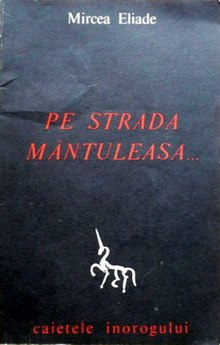 First edition First edition | |
| Author | Mircea Eliade |
|---|---|
| Original title | Pe strada Mântuleasa |
| Translator | Mary Park Stevenson |
| Language | Romanian |
| Publication date | 1967 |
| Published in English | 1979 |
| Pages | 127 |
The Old Man and the Bureaucrats (Romanian: Pe strada Mântuleasa) is a 1967 novella by the Romanian writer Mircea Eliade. It tells the story of a man who is interrogated by Romania's communist authorities, and puzzles the interrogators when he tells stories of local lore. The book was published in English in 1979. Together with two other stories by Eliade it forms the basis for the 1996 film Eu sunt Adam.
Themes
Mircea Eliade wrote about his aim with the novella: "I wanted to engineer a confrontation between two mythologies: the mythology of folklore, of the people, which is still alive, still welling up in the old man, and the mythology of the modern world, of technocracy. ... These two mythologies meet head on. The police try to discover the hidden meaning of all these stories. ... But they are also blinkered, they can only look for political secrets. ... They are incapable of imagining that there can be meaning outside the political field."
Bibliography
- Bogdan, Andrei (2000). "Ambiguitate şi semnificaţie în "Pe strada Mântuleasa" ("Ambiguity and Significance in "On Mântuleasa Street"")". Revista Literară Vatra (in Romanian) (6–7): 13–16. ISSN 1220-6334.
References
- The Old Man and the Bureaucrats. OCLC 5286248. Retrieved 2013-10-07 – via WorldCat.
- Scarlat, Cristina (2005-01-23). "Cristina Scarlat în dialog cu Nicolae Brânduş". Nord Literar (in Romanian). Retrieved 2014-12-25.
- Carnis-Pope, Marcel (2007). "The Question of Folklore in Romanian Literary Culture". In Carnis-Pope, Marcel; Neubauer, John (eds.). History of the Literary Cultures of East-Central Europe. Amsterdam: John Benjamins Publishing Company. p. 322. ISBN 9789027234551.
| Mircea Eliade | |
|---|---|
| Bibliography | |
| Fiction | |
| Non-fiction | |
| Theory | |
| Periodicals | |
This article about a 1960s novel is a stub. You can help Misplaced Pages by expanding it. See guidelines for writing about novels. Further suggestions might be found on the article's talk page. |